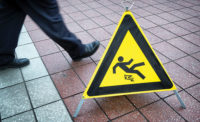Don't let safety slip away: Tips to prevent slips, trips and falls

 If you've ever slipped on an oily patch of floor or tripped over a loose piece of carpeting you know how easy it can be to take a fall.
If you've ever slipped on an oily patch of floor or tripped over a loose piece of carpeting you know how easy it can be to take a fall.
And if you did fall, you would join the more than 42,000 people who get injured each year in work-related falls. That's about seventeen percent of the "time-loss injuries" across Canada as well as a lot of economic loss, pain and suffering, and sometimes even death.
You may be surprised to learn that most falls don't happen from roofs, ladders, or any other heights. In fact, around sixty-six percent of falls happen on the same level, caused by slips and trips. Here are some things you should know to prevent "falls on the same level".
Slips and trips happen when there is some unexpected change in the contact between the feet and the ground or floor. Keeping that in mind, there are four factors that should be addressed in preventing fall accidents: 1) good housekeeping; 2) quality of walking surfaces (flooring); 3) proper footwear; and 4) pace of walking.
Good housekeeping
This is the first and the most important factor in preventing falls due to slips and trips. Be sure to:
●clean all spills immediately and mark spills and wet areas.
●mop or sweep debris from floors.
●remove obstacles from walkways and always keep them free of clutter.
●secure mats, rugs and carpets that do not lay flat with tape, tacks, etc.
●close file cabinet or storage drawers.
●cover cables that cross walkways.
●keep working areas and walkways well lit; replace used light bulbs and faulty switches.
Flooring
Changing or modifying walking surfaces to provide "sure footing" is an important step in preventing slips and trips. Recoating or replacing floors, installing mats, pressure-sensitive abrasive strips or abrasive-filled paint-on coating and metal or synthetic decking can further improve safety and reduce the risk of falling. Also, resilient, non-slippery flooring prevents or reduces foot fatigue and can help prevent slips.
Footwear
In workplaces where floors may be oily or wet or where workers spend a lot of time outdoors, selecting proper footwear is essential to preventing fall accidents. Since there is no anti-slip footwear ideal for every condition, it is recommended that you consult with manufacturers for the available options best suited to your needs. Wearing footwear that fits properly increases your comfort and prevents fatigue which, in turn, improves your safety.
Steps you can take to avoid falling at work
Safety is everybody's business; however, it is employers' responsibility to provide a safe work environment for all employees. As an employee there are steps you can take to avoid falling at work.
You can reduce the risk of slipping on wet flooring by:
● taking your time and paying attention to where you are going.
● walking at a pace that is suitable for the walking surface and the tasks you are doing.
● walking with your feet pointed slightly outward.
● making wide turns at corners.
You can reduce the risk of tripping by:
● keeping walking areas clear from clutter or obstructions.
● keeping flooring in good condition.
● using installed light sources that provide sufficient light for your tasks.
● using a flashlight if you enter a dark room where there is no light.
● ensuring that things you are carrying or pushing do not prevent you from seeing any obstructions, spills, etc.
CCOHS Resources
Prevention of Slips, Trips and Fallsfact sheet
Preventing Falls From Slips and Tripse-course
Canadian Centre for Occupational Safety and Health CCOSH
Looking for a reprint of this article?
From high-res PDFs to custom plaques, order your copy today!




